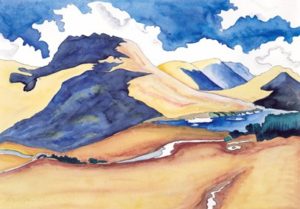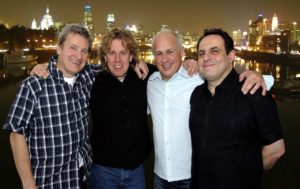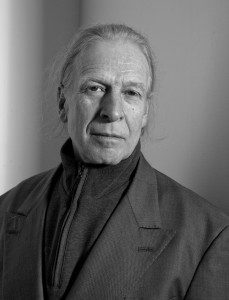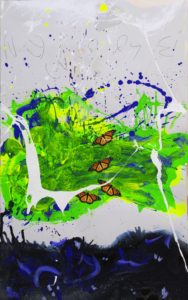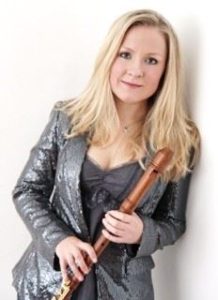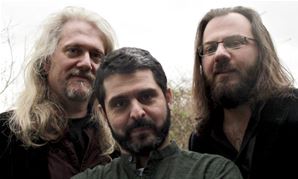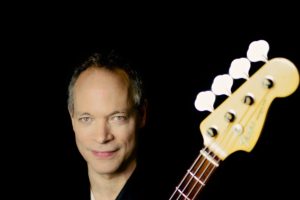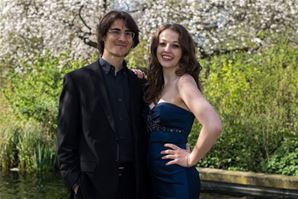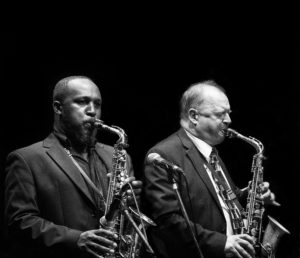This exhibition entitled Energy shows mixed media land and seascape originals, limited edition prints, and seven small oil paintings illustrating the landform project being created in Cornwall. Elspeth works on the cusp of abstraction and figuration. “I attempt to reveal energy, a vitality which, once engaged, never diminishes with time.” This has been the appeal.
Elspeth qualified as an architect from Liverpool University, practiced for years and was invited to teach soon after qualifying. She has no formal training in painting but as an architect was regularly asked to make substantial commissions in glass and paint, and to lecture abroad.
She designed three large stained windows in West London in 1981, 1989 and 1996, and in 1983 painted a huge political cartoon, a mural in a house in Westminster for an active politician. It was during these projects she realized the power of communication through composition. In 1999 Elspeth was shortlisted for Millennium artist for North Cornwall. Six interactive proposals were made, all local and doable, including a dark skies project down-directing street lighting – all seen as too ambitious.
This exhibition can be seen as a retrospective on 20 years of painting. Three years of blindness (2013-16) make this show a real celebration and a natural transition to any potential new work. Elspeth started painting landscapes in 1991 while teaching design workshops in Australia. In November last year she returned, with improved – but impaired – vision, to Australia to paint the extreme coastal points including Point Lookout in the west and Albany in the south-west, which may lead to an inevitably different style of future work, but for now a celebration of sight and works dated to 2013.
Initially Elspeth exhibited her paintings in themed shows, for example at Salisbury Playhouse in 1996, with 80 small works around the drum to highlight erosion and pollution (the Sea Empress oil spill off west Wales and the breakage of Spurn Point road in Lincolnshire), issues in the environment but always the aesthetics of light, heat and sound as space makers, interactions that make a whole. This interest, focusing on energy and environmental conditions, has been reflected in the choice of subject and titles of earlier exhibitions. She has held a total of 22 exhibitions in London and elsewhere since 1994 and reviews, including the Spectator in 2002, have recommended a wider audience. She has also been interviewed on radio: Woman’s Hour 1994, BBC Radio 4 2013 and Liverpool City Radio 2008. Her paintings are held in collections in the UK and overseas. The concerns reflected in her shows underpin the educational facility in Cornwall as it progresses.
Intensity is a quality that penetrates the images which range from the quietude of a scene on the Thames to a force 9 wave off Land’s End. The interrelationship of abstraction and figuration mentioned earlier remains the prime creative interest to the artist. A timeless zero.
The next few years may prove very different. Elspeth hopes you and your friends will share refreshments with her as this new journey commences. She will be in the gallery throughout the exhibition.
Image: Shadows near Bridge of Orchy © Elspeth Hamilton, 2016. All Rights Reserved
Tuesday-Friday 13:00-17:00; Saturday 11:00-16:00; Sunday 11:00-17:00. Closed Monday
10-23 March
This exhibition entitled Energy shows mixed media land and seascape originals, limited edition prints, and seven small oil paintings illustrating the landform project being created in Cornwall. Elspeth works on the cusp of abstraction and figuration. “I attempt to reveal energy, a vitality which, once engaged, never diminishes with time.” This has been the appeal.
Elspeth qualified as an architect from Liverpool University, practiced for years and was invited to teach soon after qualifying. She has no formal training in painting but as an architect was regularly asked to make substantial commissions in glass and paint, and to lecture abroad.
She designed three large stained windows in West London in 1981, 1989 and 1996, and in 1983 painted a huge political cartoon, a mural in a house in Westminster for an active politician. It was during these projects she realized the power of communication through composition. In 1999 Elspeth was shortlisted for Millennium artist for North Cornwall. Six interactive proposals were made, all local and doable, including a dark skies project down-directing street lighting – all seen as too ambitious.
This exhibition can be seen as a retrospective on 20 years of painting. Three years of blindness (2013-16) make this show a real celebration and a natural transition to any potential new work. Elspeth started painting landscapes in 1991 while teaching design workshops in Australia. In November last year she returned, with improved – but impaired – vision, to Australia to paint the extreme coastal points including Point Lookout in the west and Albany in the south-west, which may lead to an inevitably different style of future work, but for now a celebration of sight and works dated to 2013.
Initially Elspeth exhibited her paintings in themed shows, for example at Salisbury Playhouse in 1996, with 80 small works around the drum to highlight erosion and pollution (the Sea Empress oil spill off west Wales and the breakage of Spurn Point road in Lincolnshire), issues in the environment but always the aesthetics of light, heat and sound as space makers, interactions that make a whole. This interest, focusing on energy and environmental conditions, has been reflected in the choice of subject and titles of earlier exhibitions. She has held a total of 22 exhibitions in London and elsewhere since 1994 and reviews, including the Spectator in 2002, have recommended a wider audience. She has also been interviewed on radio: Woman’s Hour 1994, BBC Radio 4 2013 and Liverpool City Radio 2008. Her paintings are held in collections in the UK and overseas. The concerns reflected in her shows underpin the educational facility in Cornwall as it progresses.
Intensity is a quality that penetrates the images which range from the quietude of a scene on the Thames to a force 9 wave off Land’s End. The interrelationship of abstraction and figuration mentioned earlier remains the prime creative interest to the artist. A timeless zero.
The next few years may prove very different. Elspeth hopes you and your friends will share refreshments with her as this new journey commences. She will be in the gallery throughout the exhibition.
Image: Shadows near Bridge of Orchy © Elspeth Hamilton, 2016. All Rights Reserved
Tuesday-Friday 13:00-17:00
Saturday 11:00-16:00
Sunday 11:00-17:00
Closed Monday
10-23 March 2017
This exhibition entitled Energy shows mixed media land and seascape originals, limited edition prints, and seven small oil paintings illustrating the landform project being created in Cornwall. Elspeth works on the cusp of abstraction and figuration. “I attempt to reveal energy, a vitality which, once engaged, never diminishes with time.” This has been the appeal.
Elspeth qualified as an architect from Liverpool University, practiced for years and was invited to teach soon after qualifying. She has no formal training in painting but as an architect was regularly asked to make substantial commissions in glass and paint, and to lecture abroad.
She designed three large stained windows in West London in 1981, 1989 and 1996, and in 1983 painted a huge political cartoon, a mural in a house in Westminster for an active politician. It was during these projects she realized the power of communication through composition. In 1999 Elspeth was shortlisted for Millennium artist for North Cornwall. Six interactive proposals were made, all local and doable, including a dark skies project down-directing street lighting – all seen as too ambitious.
This exhibition can be seen as a retrospective on 20 years of painting. Three years of blindness (2013-16) make this show a real celebration and a natural transition to any potential new work. Elspeth started painting landscapes in 1991 while teaching design workshops in Australia. In November last year she returned, with improved – but impaired – vision, to Australia to paint the extreme coastal points including Point Lookout in the west and Albany in the south-west, which may lead to an inevitably different style of future work, but for now a celebration of sight and works dated to 2013.
Initially Elspeth exhibited her paintings in themed shows, for example at Salisbury Playhouse in 1996, with 80 small works around the drum to highlight erosion and pollution (the Sea Empress oil spill off west Wales and the breakage of Spurn Point road in Lincolnshire), issues in the environment but always the aesthetics of light, heat and sound as space makers, interactions that make a whole. This interest, focusing on energy and environmental conditions, has been reflected in the choice of subject and titles of earlier exhibitions. She has held a total of 22 exhibitions in London and elsewhere since 1994 and reviews, including the Spectator in 2002, have recommended a wider audience. She has also been interviewed on radio: Woman’s Hour 1994, BBC Radio 4 2013 and Liverpool City Radio 2008. Her paintings are held in collections in the UK and overseas. The concerns reflected in her shows underpin the educational facility in Cornwall as it progresses.
Intensity is a quality that penetrates the images which range from the quietude of a scene on the Thames to a force 9 wave off Land’s End. The interrelationship of abstraction and figuration mentioned earlier remains the prime creative interest to the artist. A timeless zero.
The next few years may prove very different. Elspeth hopes you and your friends will share refreshments with her as this new journey commences. She will be in the gallery throughout the exhibition.
Image: Shadows near Bridge of Orchy © Elspeth Hamilton, 2016. All Rights Reserved
Tuesday-Friday 13:00-17:00
Saturday 11:00-16:00
Sunday 11:00-17:00
Closed Monday
10-23 March 2017
This exhibition entitled Energy shows mixed media land and seascape originals, limited edition prints, and seven small oil paintings illustrating the landform project being created in Cornwall. Elspeth works on the cusp of abstraction and figuration. “I attempt to reveal energy, a vitality which, once engaged, never diminishes with time.” This has been the appeal.
Elspeth qualified as an architect from Liverpool University, practiced for years and was invited to teach soon after qualifying. She has no formal training in painting but as an architect was regularly asked to make substantial commissions in glass and paint, and to lecture abroad.
She designed three large stained windows in West London in 1981, 1989 and 1996, and in 1983 painted a huge political cartoon, a mural in a house in Westminster for an active politician. It was during these projects she realized the power of communication through composition. In 1999 Elspeth was shortlisted for Millennium artist for North Cornwall. Six interactive proposals were made, all local and doable, including a dark skies project down-directing street lighting – all seen as too ambitious.
This exhibition can be seen as a retrospective on 20 years of painting. Three years of blindness (2013-16) make this show a real celebration and a natural transition to any potential new work. Elspeth started painting landscapes in 1991 while teaching design workshops in Australia. In November last year she returned, with improved – but impaired – vision, to Australia to paint the extreme coastal points including Point Lookout in the west and Albany in the south-west, which may lead to an inevitably different style of future work, but for now a celebration of sight and works dated to 2013.
Initially Elspeth exhibited her paintings in themed shows, for example at Salisbury Playhouse in 1996, with 80 small works around the drum to highlight erosion and pollution (the Sea Empress oil spill off west Wales and the breakage of Spurn Point road in Lincolnshire), issues in the environment but always the aesthetics of light, heat and sound as space makers, interactions that make a whole. This interest, focusing on energy and environmental conditions, has been reflected in the choice of subject and titles of earlier exhibitions. She has held a total of 22 exhibitions in London and elsewhere since 1994 and reviews, including the Spectator in 2002, have recommended a wider audience. She has also been interviewed on radio: Woman’s Hour 1994, BBC Radio 4 2013 and Liverpool City Radio 2008. Her paintings are held in collections in the UK and overseas. The concerns reflected in her shows underpin the educational facility in Cornwall as it progresses.
Intensity is a quality that penetrates the images which range from the quietude of a scene on the Thames to a force 9 wave off Land’s End. The interrelationship of abstraction and figuration mentioned earlier remains the prime creative interest to the artist. A timeless zero.
The next few years may prove very different. Elspeth hopes you and your friends will share refreshments with her as this new journey commences. She will be in the gallery throughout the exhibition.
Image: Shadows near Bridge of Orchy © Elspeth Hamilton, 2016. All Rights Reserved
Tuesday-Friday 13:00-17:00
Saturday 11:00-16:00
Sunday 11:00-17:00
Closed Monday
10-23 March 2017
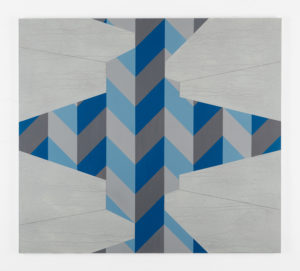
Karen Loader’s artistic interests centre around the differences and similarities between place and space. She sees place as somewhere real and tangible, that can be experienced through the senses, and space as something abstract that is felt rather than observed. Her work explores the transition from one to the other and how both are inevitably intertwined.
Her artistic process begins with walking around a place and documenting it photographically, noting things such as architectural shapes, the textures of walls, the odd juxtapositions of objects and the colours that stand out. For this exhibition, she explored her local neighbourhood – the area between Holloway and Highgate, taking in the back streets and alleyways that branch off the A1 carriageway. Moving through a place physically helps her to construct a rhythmic interpretation of it and, when combined with focused observations, the character or personality of the place starts to emerge. This is a purely subjective act and the outcomes can vary depending on the place and her perception of it.
Back in the studio, she works with these elements of rhythm and observation taking them into intuitive drawings that play with spatial divisions and colour variations. The final stage is to scale up these two processes into larger paintings that hopefully retain some of the mood of the place in which she started. Her aim is to convey an atmosphere of place that can act as a trigger for memory and association and encourage the viewer towards a more contemplative reading of the work.
She often works within the set parameters of a grid format which allows for infinite possibilities to explore spatial and structural juxtapositions, but she is always looking for the moments when the mathematical harmony is disrupted by a slippage in symmetry. Her use of a muted colour palette in thin layers of acrylic paint adds to a sense of disorientation as the eye struggles to focus on a particular point and the mind jumps from shape to shape as it attempts to make connections. Colour plays an important part in creating both the harmony and the disruption of space and is strongly related to the original starting point of a place.
Karen has lived in Holloway for over 25 years. She studied sculpture and installation at the University of East London graduating in 1999. She is currently studying for an MA in Fine Art at The City & Guilds of London Art School. Her work has been widely exhibited since 2002 and she has curated a number of exhibitions in the UK and abroad.
All works are for sale.
www.karenloader.com
28th April to 11th May 2017
Highgate Gallery open Tuesday-Friday 13:00-17:00
Saturday 11:00-16:00
Sunday 11:00-17:00
Closed Monday
Image: I Heard it on the Radio ©Karen Loader, 2016. All Rights Reserved
KAREN LOADER’s artistic interests centre around the differences and similarities between place and space. She sees place as somewhere real and tangible, that can be experienced through the senses, and space as something abstract that is felt rather than observed. Her work explores the transition from one to the other and how both are inevitably intertwined.
Her artistic process begins with walking around a place and documenting it photographically, noting things such as architectural shapes, the textures of walls, the odd juxtapositions of objects and the colours that stand out. For this exhibition, she explored her local neighbourhood – the area between Holloway and Highgate, taking in the back streets and alleyways that branch off the A1 carriageway. Moving through a place physically helps her to construct a rhythmic interpretation of it and, when combined with focused observations, the character or personality of the place starts to emerge. This is a purely subjective act and the outcomes can vary depending on the place and her perception of it.
Back in the studio, she works with these elements of rhythm and observation taking them into intuitive drawings that play with spatial divisions and colour variations. The final stage is to scale up these two processes into larger paintings that hopefully retain some of the mood of the place in which she started. Her aim is to convey an atmosphere of place that can act as a trigger for memory and association and encourage the viewer towards a more contemplative reading of the work.
She often works within the set parameters of a grid format which allows for infinite possibilities to explore spatial and structural juxtapositions, but she is always looking for the moments when the mathematical harmony is disrupted by a slippage in symmetry. Her use of a muted colour palette in thin layers of acrylic paint adds to a sense of disorientation as the eye struggles to focus on a particular point and the mind jumps from shape to shape as it attempts to make connections. Colour plays an important part in creating both the harmony and the disruption of space and is strongly related to the original starting point of a place.
Karen has lived in Holloway for over 25 years. She studied sculpture and installation at the University of East London graduating in 1999. She is currently studying for an MA in Fine Art at The City & Guilds of London Art School. Her work has been widely exhibited since 2002 and she has curated a number of exhibitions in the UK and abroad.
Gallery open Tuesday-Friday 1-5pm, Saturday 11am-4pm, Sunday 11am-5pm; closed Mondays. Exhibition continues until 11 May.
Image: I Heard it on the Radio ©Karen Loader, 2016. All Rights Reserved
KAREN LOADER’s artistic interests centre around the differences and similarities between place and space. She sees place as somewhere real and tangible, that can be experienced through the senses, and space as something abstract that is felt rather than observed. Her work explores the transition from one to the other and how both are inevitably intertwined.
Her artistic process begins with walking around a place and documenting it photographically, noting things such as architectural shapes, the textures of walls, the odd juxtapositions of objects and the colours that stand out. For this exhibition, she explored her local neighbourhood – the area between Holloway and Highgate, taking in the back streets and alleyways that branch off the A1 carriageway. Moving through a place physically helps her to construct a rhythmic interpretation of it and, when combined with focused observations, the character or personality of the place starts to emerge. This is a purely subjective act and the outcomes can vary depending on the place and her perception of it.
Back in the studio, she works with these elements of rhythm and observation taking them into intuitive drawings that play with spatial divisions and colour variations. The final stage is to scale up these two processes into larger paintings that hopefully retain some of the mood of the place in which she started. Her aim is to convey an atmosphere of place that can act as a trigger for memory and association and encourage the viewer towards a more contemplative reading of the work.
She often works within the set parameters of a grid format which allows for infinite possibilities to explore spatial and structural juxtapositions, but she is always looking for the moments when the mathematical harmony is disrupted by a slippage in symmetry. Her use of a muted colour palette in thin layers of acrylic paint adds to a sense of disorientation as the eye struggles to focus on a particular point and the mind jumps from shape to shape as it attempts to make connections. Colour plays an important part in creating both the harmony and the disruption of space and is strongly related to the original starting point of a place.
Karen has lived in Holloway for over 25 years. She studied sculpture and installation at the University of East London graduating in 1999. She is currently studying for an MA in Fine Art at The City & Guilds of London Art School. Her work has been widely exhibited since 2002 and she has curated a number of exhibitions in the UK and abroad.
Highgate Gallery open Tuesday-Friday 13:00-17:00
Saturday 11:00-16:00
Sunday 11:00-17:00
Closed Monday.
Exhibition continues until 11 May.

Karen Loader’s artistic interests centre around the differences and similarities between place and space. She sees place as somewhere real and tangible, that can be experienced through the senses, and space as something abstract that is felt rather than observed. Her work explores the transition from one to the other and how both are inevitably intertwined.
Her artistic process begins with walking around a place and documenting it photographically, noting things such as architectural shapes, the textures of walls, the odd juxtapositions of objects and the colours that stand out. For this exhibition, she explored her local neighbourhood – the area between Holloway and Highgate, taking in the back streets and alleyways that branch off the A1 carriageway. Moving through a place physically helps her to construct a rhythmic interpretation of it and, when combined with focused observations, the character or personality of the place starts to emerge. This is a purely subjective act and the outcomes can vary depending on the place and her perception of it.
Back in the studio, she works with these elements of rhythm and observation taking them into intuitive drawings that play with spatial divisions and colour variations. The final stage is to scale up these two processes into larger paintings that hopefully retain some of the mood of the place in which she started. Her aim is to convey an atmosphere of place that can act as a trigger for memory and association and encourage the viewer towards a more contemplative reading of the work.
She often works within the set parameters of a grid format which allows for infinite possibilities to explore spatial and structural juxtapositions, but she is always looking for the moments when the mathematical harmony is disrupted by a slippage in symmetry. Her use of a muted colour palette in thin layers of acrylic paint adds to a sense of disorientation as the eye struggles to focus on a particular point and the mind jumps from shape to shape as it attempts to make connections. Colour plays an important part in creating both the harmony and the disruption of space and is strongly related to the original starting point of a place.
Karen has lived in Holloway for over 25 years. She studied sculpture and installation at the University of East London graduating in 1999. She is currently studying for an MA in Fine Art at The City & Guilds of London Art School. Her work has been widely exhibited since 2002 and she has curated a number of exhibitions in the UK and abroad.
All works are for sale.
www.karenloader.com
28th April to 11th May 2017
Highgate Gallery open Tuesday-Friday 13:00-17:00
Saturday 11:00-16:00
Sunday 11:00-17:00
Closed Monday

Karen Loader’s artistic interests centre around the differences and similarities between place and space. She sees place as somewhere real and tangible, that can be experienced through the senses, and space as something abstract that is felt rather than observed. Her work explores the transition from one to the other and how both are inevitably intertwined.
Her artistic process begins with walking around a place and documenting it photographically, noting things such as architectural shapes, the textures of walls, the odd juxtapositions of objects and the colours that stand out. For this exhibition, she explored her local neighbourhood – the area between Holloway and Highgate, taking in the back streets and alleyways that branch off the A1 carriageway. Moving through a place physically helps her to construct a rhythmic interpretation of it and, when combined with focused observations, the character or personality of the place starts to emerge. This is a purely subjective act and the outcomes can vary depending on the place and her perception of it.
Back in the studio, she works with these elements of rhythm and observation taking them into intuitive drawings that play with spatial divisions and colour variations. The final stage is to scale up these two processes into larger paintings that hopefully retain some of the mood of the place in which she started. Her aim is to convey an atmosphere of place that can act as a trigger for memory and association and encourage the viewer towards a more contemplative reading of the work.
She often works within the set parameters of a grid format which allows for infinite possibilities to explore spatial and structural juxtapositions, but she is always looking for the moments when the mathematical harmony is disrupted by a slippage in symmetry. Her use of a muted colour palette in thin layers of acrylic paint adds to a sense of disorientation as the eye struggles to focus on a particular point and the mind jumps from shape to shape as it attempts to make connections. Colour plays an important part in creating both the harmony and the disruption of space and is strongly related to the original starting point of a place.
Karen has lived in Holloway for over 25 years. She studied sculpture and installation at the University of East London graduating in 1999. She is currently studying for an MA in Fine Art at The City & Guilds of London Art School. Her work has been widely exhibited since 2002 and she has curated a number of exhibitions in the UK and abroad.
All works are for sale.
www.karenloader.com
28th April to 11th May 2017
Highgate Gallery open Tuesday-Friday 13:00-17:00
Saturday 11:00-16:00
Sunday 11:00-17:00
Closed Monday

Karen Loader’s artistic interests centre around the differences and similarities between place and space. She sees place as somewhere real and tangible, that can be experienced through the senses, and space as something abstract that is felt rather than observed. Her work explores the transition from one to the other and how both are inevitably intertwined.
Her artistic process begins with walking around a place and documenting it photographically, noting things such as architectural shapes, the textures of walls, the odd juxtapositions of objects and the colours that stand out. For this exhibition, she explored her local neighbourhood – the area between Holloway and Highgate, taking in the back streets and alleyways that branch off the A1 carriageway. Moving through a place physically helps her to construct a rhythmic interpretation of it and, when combined with focused observations, the character or personality of the place starts to emerge. This is a purely subjective act and the outcomes can vary depending on the place and her perception of it.
Back in the studio, she works with these elements of rhythm and observation taking them into intuitive drawings that play with spatial divisions and colour variations. The final stage is to scale up these two processes into larger paintings that hopefully retain some of the mood of the place in which she started. Her aim is to convey an atmosphere of place that can act as a trigger for memory and association and encourage the viewer towards a more contemplative reading of the work.
She often works within the set parameters of a grid format which allows for infinite possibilities to explore spatial and structural juxtapositions, but she is always looking for the moments when the mathematical harmony is disrupted by a slippage in symmetry. Her use of a muted colour palette in thin layers of acrylic paint adds to a sense of disorientation as the eye struggles to focus on a particular point and the mind jumps from shape to shape as it attempts to make connections. Colour plays an important part in creating both the harmony and the disruption of space and is strongly related to the original starting point of a place.
Karen has lived in Holloway for over 25 years. She studied sculpture and installation at the University of East London graduating in 1999. She is currently studying for an MA in Fine Art at The City & Guilds of London Art School. Her work has been widely exhibited since 2002 and she has curated a number of exhibitions in the UK and abroad.
All works are for sale.
www.karenloader.com
28th April to 11th May 2017
Highgate Gallery open Tuesday-Friday 13:00-17:00
Saturday 11:00-16:00
Sunday 11:00-17:00
Closed Monday
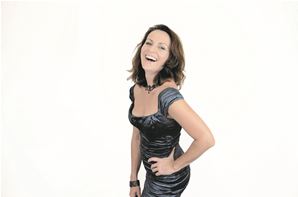 karen lane presents the music of nancy wilson & cannonball adderley
karen lane presents the music of nancy wilson & cannonball adderley
thursday 4 may
With Martin Hathaway | alto, Steve Fishwick | trumpet
Graham Harvey |piano, Simon Woolf | bass, Matt Fishwick | drums
Arriving from Australia in 2000 after performing at many of the big Asian Festivals, Karen has released five albums to critical acclaim. She’s worked with some of our finest musicians including Tom Cawley, Andy Hamill and Robin Aspland and has found herself performing in exotic places she’d never imagined she’d see including Sicily, Portafino, Nice, Monte Carlo, Berlin, Cape Town and Bucharest.
Her visit to Lauderdale House will be a unique date on the London scene when she recreates the music of Nancy Wilson. Had she not coincided with the advent of rock and soul, Nancy Wilson would have been considered one of the greatest female jazz singers of them all. Luckily she did record a number of albums with one of the greatest jazz musicians of all time, Cannonball Adderley and Karen thinks it’s high time Nancy’s music was reassessed. This is going to be a concert you should not miss!
“.. a fine and distinctive singer” Dave Gelly, The Observer
“.. as accomplished.. as I have heard this year” Peter Quinn, Jazzwise
Time: 20:30
Venue: Lauderdale House
£7 STUDENT CONCESSION
| Price band | A | B |
| Standard | £12.00 | |
| Concession | £10.00 | |
| Child | £7.00 |
Concessions are available for students, people on benefit and over 60s. Proof must be provided when collecting tickets.
to book
Box office: 0208 348 8716
Email: enquiries@lauderdale.org.uk
Website: www.lauderdalehouse.org.uk

Karen Loader’s artistic interests centre around the differences and similarities between place and space. She sees place as somewhere real and tangible, that can be experienced through the senses, and space as something abstract that is felt rather than observed. Her work explores the transition from one to the other and how both are inevitably intertwined.
Her artistic process begins with walking around a place and documenting it photographically, noting things such as architectural shapes, the textures of walls, the odd juxtapositions of objects and the colours that stand out. For this exhibition, she explored her local neighbourhood – the area between Holloway and Highgate, taking in the back streets and alleyways that branch off the A1 carriageway. Moving through a place physically helps her to construct a rhythmic interpretation of it and, when combined with focused observations, the character or personality of the place starts to emerge. This is a purely subjective act and the outcomes can vary depending on the place and her perception of it.
Back in the studio, she works with these elements of rhythm and observation taking them into intuitive drawings that play with spatial divisions and colour variations. The final stage is to scale up these two processes into larger paintings that hopefully retain some of the mood of the place in which she started. Her aim is to convey an atmosphere of place that can act as a trigger for memory and association and encourage the viewer towards a more contemplative reading of the work.
She often works within the set parameters of a grid format which allows for infinite possibilities to explore spatial and structural juxtapositions, but she is always looking for the moments when the mathematical harmony is disrupted by a slippage in symmetry. Her use of a muted colour palette in thin layers of acrylic paint adds to a sense of disorientation as the eye struggles to focus on a particular point and the mind jumps from shape to shape as it attempts to make connections. Colour plays an important part in creating both the harmony and the disruption of space and is strongly related to the original starting point of a place.
Karen has lived in Holloway for over 25 years. She studied sculpture and installation at the University of East London graduating in 1999. She is currently studying for an MA in Fine Art at The City & Guilds of London Art School. Her work has been widely exhibited since 2002 and she has curated a number of exhibitions in the UK and abroad.
All works are for sale.
www.karenloader.com
28th April to 11th May 2017
Highgate Gallery open Tuesday-Friday 13:00-17:00
Saturday 11:00-16:00
Sunday 11:00-17:00
Closed Monday
Image: I Heard it on the Radio ©Karen Loader, 2016. All Rights Reserved
KAREN LOADER’s artistic interests centre around the differences and similarities between place and space. She sees place as somewhere real and tangible, that can be experienced through the senses, and space as something abstract that is felt rather than observed. Her work explores the transition from one to the other and how both are inevitably intertwined.
Her artistic process begins with walking around a place and documenting it photographically, noting things such as architectural shapes, the textures of walls, the odd juxtapositions of objects and the colours that stand out. For this exhibition, she explored her local neighbourhood – the area between Holloway and Highgate, taking in the back streets and alleyways that branch off the A1 carriageway. Moving through a place physically helps her to construct a rhythmic interpretation of it and, when combined with focused observations, the character or personality of the place starts to emerge. This is a purely subjective act and the outcomes can vary depending on the place and her perception of it.
Back in the studio, she works with these elements of rhythm and observation taking them into intuitive drawings that play with spatial divisions and colour variations. The final stage is to scale up these two processes into larger paintings that hopefully retain some of the mood of the place in which she started. Her aim is to convey an atmosphere of place that can act as a trigger for memory and association and encourage the viewer towards a more contemplative reading of the work.
She often works within the set parameters of a grid format which allows for infinite possibilities to explore spatial and structural juxtapositions, but she is always looking for the moments when the mathematical harmony is disrupted by a slippage in symmetry. Her use of a muted colour palette in thin layers of acrylic paint adds to a sense of disorientation as the eye struggles to focus on a particular point and the mind jumps from shape to shape as it attempts to make connections. Colour plays an important part in creating both the harmony and the disruption of space and is strongly related to the original starting point of a place.
Karen has lived in Holloway for over 25 years. She studied sculpture and installation at the University of East London graduating in 1999. She is currently studying for an MA in Fine Art at The City & Guilds of London Art School. Her work has been widely exhibited since 2002 and she has curated a number of exhibitions in the UK and abroad.
Gallery open Tuesday-Friday 1-5pm, Saturday 11am-4pm, Sunday 11am-5pm; closed Mondays. Exhibition continues until 11 May.
Image: I Heard it on the Radio ©Karen Loader, 2016. All Rights Reserved
KAREN LOADER’s artistic interests centre around the differences and similarities between place and space. She sees place as somewhere real and tangible, that can be experienced through the senses, and space as something abstract that is felt rather than observed. Her work explores the transition from one to the other and how both are inevitably intertwined.
Her artistic process begins with walking around a place and documenting it photographically, noting things such as architectural shapes, the textures of walls, the odd juxtapositions of objects and the colours that stand out. For this exhibition, she explored her local neighbourhood – the area between Holloway and Highgate, taking in the back streets and alleyways that branch off the A1 carriageway. Moving through a place physically helps her to construct a rhythmic interpretation of it and, when combined with focused observations, the character or personality of the place starts to emerge. This is a purely subjective act and the outcomes can vary depending on the place and her perception of it.
Back in the studio, she works with these elements of rhythm and observation taking them into intuitive drawings that play with spatial divisions and colour variations. The final stage is to scale up these two processes into larger paintings that hopefully retain some of the mood of the place in which she started. Her aim is to convey an atmosphere of place that can act as a trigger for memory and association and encourage the viewer towards a more contemplative reading of the work.
She often works within the set parameters of a grid format which allows for infinite possibilities to explore spatial and structural juxtapositions, but she is always looking for the moments when the mathematical harmony is disrupted by a slippage in symmetry. Her use of a muted colour palette in thin layers of acrylic paint adds to a sense of disorientation as the eye struggles to focus on a particular point and the mind jumps from shape to shape as it attempts to make connections. Colour plays an important part in creating both the harmony and the disruption of space and is strongly related to the original starting point of a place.
Karen has lived in Holloway for over 25 years. She studied sculpture and installation at the University of East London graduating in 1999. She is currently studying for an MA in Fine Art at The City & Guilds of London Art School. Her work has been widely exhibited since 2002 and she has curated a number of exhibitions in the UK and abroad.
Highgate Gallery open Tuesday-Friday 13:00-17:00
Saturday 11:00-16:00
Sunday 11:00-17:00
Closed Monday.
Exhibition continues until 11 May.

Karen Loader’s artistic interests centre around the differences and similarities between place and space. She sees place as somewhere real and tangible, that can be experienced through the senses, and space as something abstract that is felt rather than observed. Her work explores the transition from one to the other and how both are inevitably intertwined.
Her artistic process begins with walking around a place and documenting it photographically, noting things such as architectural shapes, the textures of walls, the odd juxtapositions of objects and the colours that stand out. For this exhibition, she explored her local neighbourhood – the area between Holloway and Highgate, taking in the back streets and alleyways that branch off the A1 carriageway. Moving through a place physically helps her to construct a rhythmic interpretation of it and, when combined with focused observations, the character or personality of the place starts to emerge. This is a purely subjective act and the outcomes can vary depending on the place and her perception of it.
Back in the studio, she works with these elements of rhythm and observation taking them into intuitive drawings that play with spatial divisions and colour variations. The final stage is to scale up these two processes into larger paintings that hopefully retain some of the mood of the place in which she started. Her aim is to convey an atmosphere of place that can act as a trigger for memory and association and encourage the viewer towards a more contemplative reading of the work.
She often works within the set parameters of a grid format which allows for infinite possibilities to explore spatial and structural juxtapositions, but she is always looking for the moments when the mathematical harmony is disrupted by a slippage in symmetry. Her use of a muted colour palette in thin layers of acrylic paint adds to a sense of disorientation as the eye struggles to focus on a particular point and the mind jumps from shape to shape as it attempts to make connections. Colour plays an important part in creating both the harmony and the disruption of space and is strongly related to the original starting point of a place.
Karen has lived in Holloway for over 25 years. She studied sculpture and installation at the University of East London graduating in 1999. She is currently studying for an MA in Fine Art at The City & Guilds of London Art School. Her work has been widely exhibited since 2002 and she has curated a number of exhibitions in the UK and abroad.
All works are for sale.
www.karenloader.com
28th April to 11th May 2017
Highgate Gallery open Tuesday-Friday 13:00-17:00
Saturday 11:00-16:00
Sunday 11:00-17:00
Closed Monday

Karen Loader’s artistic interests centre around the differences and similarities between place and space. She sees place as somewhere real and tangible, that can be experienced through the senses, and space as something abstract that is felt rather than observed. Her work explores the transition from one to the other and how both are inevitably intertwined.
Her artistic process begins with walking around a place and documenting it photographically, noting things such as architectural shapes, the textures of walls, the odd juxtapositions of objects and the colours that stand out. For this exhibition, she explored her local neighbourhood – the area between Holloway and Highgate, taking in the back streets and alleyways that branch off the A1 carriageway. Moving through a place physically helps her to construct a rhythmic interpretation of it and, when combined with focused observations, the character or personality of the place starts to emerge. This is a purely subjective act and the outcomes can vary depending on the place and her perception of it.
Back in the studio, she works with these elements of rhythm and observation taking them into intuitive drawings that play with spatial divisions and colour variations. The final stage is to scale up these two processes into larger paintings that hopefully retain some of the mood of the place in which she started. Her aim is to convey an atmosphere of place that can act as a trigger for memory and association and encourage the viewer towards a more contemplative reading of the work.
She often works within the set parameters of a grid format which allows for infinite possibilities to explore spatial and structural juxtapositions, but she is always looking for the moments when the mathematical harmony is disrupted by a slippage in symmetry. Her use of a muted colour palette in thin layers of acrylic paint adds to a sense of disorientation as the eye struggles to focus on a particular point and the mind jumps from shape to shape as it attempts to make connections. Colour plays an important part in creating both the harmony and the disruption of space and is strongly related to the original starting point of a place.
Karen has lived in Holloway for over 25 years. She studied sculpture and installation at the University of East London graduating in 1999. She is currently studying for an MA in Fine Art at The City & Guilds of London Art School. Her work has been widely exhibited since 2002 and she has curated a number of exhibitions in the UK and abroad.
All works are for sale.
www.karenloader.com
28th April to 11th May 2017
Highgate Gallery open Tuesday-Friday 13:00-17:00
Saturday 11:00-16:00
Sunday 11:00-17:00
Closed Monday

Karen Loader’s artistic interests centre around the differences and similarities between place and space. She sees place as somewhere real and tangible, that can be experienced through the senses, and space as something abstract that is felt rather than observed. Her work explores the transition from one to the other and how both are inevitably intertwined.
Her artistic process begins with walking around a place and documenting it photographically, noting things such as architectural shapes, the textures of walls, the odd juxtapositions of objects and the colours that stand out. For this exhibition, she explored her local neighbourhood – the area between Holloway and Highgate, taking in the back streets and alleyways that branch off the A1 carriageway. Moving through a place physically helps her to construct a rhythmic interpretation of it and, when combined with focused observations, the character or personality of the place starts to emerge. This is a purely subjective act and the outcomes can vary depending on the place and her perception of it.
Back in the studio, she works with these elements of rhythm and observation taking them into intuitive drawings that play with spatial divisions and colour variations. The final stage is to scale up these two processes into larger paintings that hopefully retain some of the mood of the place in which she started. Her aim is to convey an atmosphere of place that can act as a trigger for memory and association and encourage the viewer towards a more contemplative reading of the work.
She often works within the set parameters of a grid format which allows for infinite possibilities to explore spatial and structural juxtapositions, but she is always looking for the moments when the mathematical harmony is disrupted by a slippage in symmetry. Her use of a muted colour palette in thin layers of acrylic paint adds to a sense of disorientation as the eye struggles to focus on a particular point and the mind jumps from shape to shape as it attempts to make connections. Colour plays an important part in creating both the harmony and the disruption of space and is strongly related to the original starting point of a place.
Karen has lived in Holloway for over 25 years. She studied sculpture and installation at the University of East London graduating in 1999. She is currently studying for an MA in Fine Art at The City & Guilds of London Art School. Her work has been widely exhibited since 2002 and she has curated a number of exhibitions in the UK and abroad.
All works are for sale.
www.karenloader.com
28th April to 11th May 2017
Highgate Gallery open Tuesday-Friday 13:00-17:00
Saturday 11:00-16:00
Sunday 11:00-17:00
Closed Monday
With Robin Aspland | piano, Simon Thorpe | bass
Milo Fell | drums
Roger was a late starter as a musician playing his first concert aged 28. He was one of the founding members of the Chevalier Brothers in the 1980s and played about 1,000 gigs all over the world with them. He then signed to Acid Jazz Records and started releasing highly regarded solo albums under the name of The Beaujolais Band & Vibraphonic. With Vibraphonic he had a number one hit on the US jazz charts and as a result he was signed to Disney’s Hollywood Records in LA and released two albums for them. Since 2000 Roger has concentrated on more acoustic jazz. Roger has played with most of the top jazz musicians in the UK along with Slim Gaillard, Pee Wee Ellis and others. Roger has also been prolific in the studio working on albums for many pop artists including Robert Plant, Paul Weller, Roni Size, Kirsty MacColl, Morrissey, Fairground Attraction, Rumer, Duffy, Alison Limerick, Alexander O’Neal, Omara Portuondo, Ed Motta, Shola Ama and many others.
In a blindfold test the main man of vibes Gary Burton thought that Beaujolais was ‘one of the top vibes players of the USA’. Favouring the music of 70s New York and writers like Bobby Hutcherson. McCoy Tyner, Joe Henderson and Wayne Shorter, as well as his own material with dryly humourous titles like Joe Beam and Mr Non PC, this is a near perfect band of great players whose sole aim is to give us ‘a couple of hours of seriously inventive improvisation’ based on great tunes, understated grooves and swing
carol grimes band
thursday 18 may
With Annie Whitehead | trombone, Richard Bundy | piano
Neville Malcolm | bass, Winston Clifford | drums
From her earliest beginnings busking on the streets of London to her appearance at the first ever Glastonbury Festival and her two solo albumms recorded in Memphis alongside greats like the Brecker Brothers and her appearances with contemporary ‘classical’ choir The Shout, Carol Grimes is a true artist and unique presence on the British scene. Her performances of jazz, blues, the occasional standard and maybe a poem ensure that she is always one of our most popular artists; someone who inspirese real affection. With its subtle grooves laid down by Malcolm and Clifford and the declamatory shouts of the wonderful trombonist Annie Whitehead this is one of the most genuine and human attractions to be seen anywhere.
Time: 20:30
Venue: Lauderdale House
£7 STUDENT CONCESSION
| Price band | A | B |
| Standard | £12.00 | |
| Concession | £10.00 | |
| Child | £7.00 |
Concessions are available for students, people on benefit and over 60s. Proof must be provided when collecting tickets.
to book
Box office: 0208 348 8716
Email: enquiries@lauderdale.org.uk
Website: www.lauderdalehouse.org.uk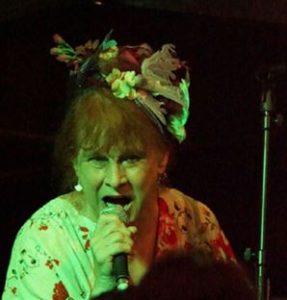
Image: Monarch migration ©Tom Scase, 2016. All Rights Reserved
The Gaia Principle: 19 May – 1 June
How organisms interact with their inorganic surroundings on earth to form a synergistic self-regulating complex system that helps to maintain and perpetuate the conditions for life on the planet (involving the earth’s biosphere, atmosphere, oceans and soil). (Wikipedia)
Tom Scase’s new work is made up of disparate elements that combine to form a symbiotic whole, where the image has no words, is beyond verbal description and exists in its visual form only as a specialised component, bringing to our attention how we interact and are a part of this perilous and extraordinary nature.
His canvas is a collage of ideas, sometimes deceptively simple, others as a cacophony of intricate brush strokes from which a strange and beautiful form emerges.
Tom is an elected member (2001) of the prestigious London Group. He has won prizes for painting and photography and has exhibited widely. He lives and works in Highgate, London.
Highgate Gallery open Tuesday-Friday 13:00-17:00
Saturday 11:00-16:00
Sunday 11:00-17:00
Closed Monday
Image: Monarch migration ©Tom Scase, 2016. All Rights Reserved
The Gaia Principle: 19 May – 1 June
How organisms interact with their inorganic surroundings on earth to form a synergistic self-regulating complex system that helps to maintain and perpetuate the conditions for life on the planet (involving the earth’s biosphere, atmosphere, oceans and soil). (Wikipedia)
Tom Scase’s new work is made up of disparate elements that combine to form a symbiotic whole, where the image has no words, is beyond verbal description and exists in its visual form only as a specialised component, bringing to our attention how we interact and are a part of this perilous and extraordinary nature.
His canvas is a collage of ideas, sometimes deceptively simple, others as a cacophony of intricate brush strokes from which a strange and beautiful form emerges.
Tom is an elected member (2001) of the prestigious London Group. He has won prizes for painting and photography and has exhibited widely. He lives and works in Highgate, London.
Highgate Gallery open Tuesday-Friday 13:00-17:00
Saturday 11:00-16:00
Sunday 11:00-17:00
Closed Monday
Image: Monarch migration ©Tom Scase, 2016. All Rights Reserved
The Gaia Principle: 19 May – 1 June
How organisms interact with their inorganic surroundings on earth to form a synergistic self-regulating complex system that helps to maintain and perpetuate the conditions for life on the planet (involving the earth’s biosphere, atmosphere, oceans and soil). (Wikipedia)
Tom Scase’s new work is made up of disparate elements that combine to form a symbiotic whole, where the image has no words, is beyond verbal description and exists in its visual form only as a specialised component, bringing to our attention how we interact and are a part of this perilous and extraordinary nature.
His canvas is a collage of ideas, sometimes deceptively simple, others as a cacophony of intricate brush strokes from which a strange and beautiful form emerges.
Tom is an elected member (2001) of the prestigious London Group. He has won prizes for painting and photography and has exhibited widely. He lives and works in Highgate, London.
Highgate Gallery open Tuesday-Friday 13:00-17:00
Saturday 11:00-16:00
Sunday 11:00-17:00
Closed Monday
Cabaret at Tea Time
In homage to our glorious past – after the House was restored in 1893 it served as the Waterlow Park tearoom for 70 years- we’re introducing Cabaret at Tea Time with a ticket offer that combines a high tea plus cabaret ticket. What better way to spend a Sunday than with a drink, food, and amazing cabaret!
Cabaret Tea A – £28.50
Glass of Prosecco
Hot smoked salmon with cream cheese and chive bridge roll
Free-range egg mayonnaise and mustard cress bridge roll
Rich chocolate brownie square
Cabaret Tea B – £25.50
Luscombe Wild Bubbly Elderflower Presse
Hot smoked salmon with cream cheese and chive bridge roll
Free-egg mayonnaise and mustard cress bridge roll
Rich chocolate brownie square
If you just want to join us for Cabaret then you can purchase a full price ticket for £16.00 / £14.00 concession for students, unwaged & Equity members only.
Host: Tim McArthur
Headline: Nadim Naaman
http://www.lauderdalehouse.org.uk http:/lauderdalehouse.org.uk
Image: Monarch migration ©Tom Scase, 2016. All Rights Reserved
The Gaia Principle: 19 May – 1 June
How organisms interact with their inorganic surroundings on earth to form a synergistic self-regulating complex system that helps to maintain and perpetuate the conditions for life on the planet (involving the earth’s biosphere, atmosphere, oceans and soil). (Wikipedia)
Tom Scase’s new work is made up of disparate elements that combine to form a symbiotic whole, where the image has no words, is beyond verbal description and exists in its visual form only as a specialised component, bringing to our attention how we interact and are a part of this perilous and extraordinary nature.
His canvas is a collage of ideas, sometimes deceptively simple, others as a cacophony of intricate brush strokes from which a strange and beautiful form emerges.
Tom is an elected member (2001) of the prestigious London Group. He has won prizes for painting and photography and has exhibited widely. He lives and works in Highgate, London.
Highgate Gallery open Tuesday-Friday 13:00-17:00
Saturday 11:00-16:00
Sunday 11:00-17:00
Closed Monday
Image: Monarch migration ©Tom Scase, 2016. All Rights Reserved
The Gaia Principle: 19 May – 1 June
How organisms interact with their inorganic surroundings on earth to form a synergistic self-regulating complex system that helps to maintain and perpetuate the conditions for life on the planet (involving the earth’s biosphere, atmosphere, oceans and soil). (Wikipedia)
Tom Scase’s new work is made up of disparate elements that combine to form a symbiotic whole, where the image has no words, is beyond verbal description and exists in its visual form only as a specialised component, bringing to our attention how we interact and are a part of this perilous and extraordinary nature.
His canvas is a collage of ideas, sometimes deceptively simple, others as a cacophony of intricate brush strokes from which a strange and beautiful form emerges.
Tom is an elected member (2001) of the prestigious London Group. He has won prizes for painting and photography and has exhibited widely. He lives and works in Highgate, London.
Highgate Gallery open Tuesday-Friday 13:00-17:00
Saturday 11:00-16:00
Sunday 11:00-17:00
Closed Monday
Image: Monarch migration ©Tom Scase, 2016. All Rights Reserved
The Gaia Principle: 19 May – 1 June
How organisms interact with their inorganic surroundings on earth to form a synergistic self-regulating complex system that helps to maintain and perpetuate the conditions for life on the planet (involving the earth’s biosphere, atmosphere, oceans and soil). (Wikipedia)
Tom Scase’s new work is made up of disparate elements that combine to form a symbiotic whole, where the image has no words, is beyond verbal description and exists in its visual form only as a specialised component, bringing to our attention how we interact and are a part of this perilous and extraordinary nature.
His canvas is a collage of ideas, sometimes deceptively simple, others as a cacophony of intricate brush strokes from which a strange and beautiful form emerges.
Tom is an elected member (2001) of the prestigious London Group. He has won prizes for painting and photography and has exhibited widely. He lives and works in Highgate, London.
Highgate Gallery open Tuesday-Friday 13:00-17:00
Saturday 11:00-16:00
Sunday 11:00-17:00
Closed Monday
alec dankworth’s world spirit
thursday 25 may
Alec Dankworth | bass guitar, Emily Dankworth | vocals
Julian Siegel | sax, Winston Clifford | percussion
Formed out of Alec’s love of music from the Iberian peninsula, World Spirit crosses the Straits of Gibraltar into Africa and beyond. Alec has joined forces with daughter Emily Dankworth, leading tenorist Julian Siegel and drummer Winston Clifford to explore melodies from Africa, South America and other continents from a jazz perspective. With tunes by Duke Ellington, Bela Fleck, Antonio-Carlos Jobim, Abdullah Ibrahim and WC Handy originating from Ireland, Venezuela, Bulgaria, South Africa, Mali and Brazil, World Spirit offers an evening of global song and improvisation.
Alec Dankworth has worked with artists as diverse as Stephane Grappelli, Abdullah Ibrahim and Van Morrison. After studying at Berklee College of Music, Alec became a member of various groups, notably Clark Tracey, Julian Joseph and Nigel Kennedy. During a period of residency in New York he played with the Duke Ellington Orchestra and joined the Dave Brubeck Quartet. As well as running his own bands, he is a member of Ginger Baker’s Jazz Confusion.
Emily Dankworth’s voice is forged from the DNA of Jazz royalty. She has sung in choirs all her life, and in 2011 studied jazz vocals at the Guildhall School of Music. She now sings in the acapella group Vive and has performed in the UK and Europe. She also sings with Alec’s Spanish Accents and works with her own group.
Image: Monarch migration ©Tom Scase, 2016. All Rights Reserved
The Gaia Principle: 19 May – 1 June
How organisms interact with their inorganic surroundings on earth to form a synergistic self-regulating complex system that helps to maintain and perpetuate the conditions for life on the planet (involving the earth’s biosphere, atmosphere, oceans and soil). (Wikipedia)
Tom Scase’s new work is made up of disparate elements that combine to form a symbiotic whole, where the image has no words, is beyond verbal description and exists in its visual form only as a specialised component, bringing to our attention how we interact and are a part of this perilous and extraordinary nature.
His canvas is a collage of ideas, sometimes deceptively simple, others as a cacophony of intricate brush strokes from which a strange and beautiful form emerges.
Tom is an elected member (2001) of the prestigious London Group. He has won prizes for painting and photography and has exhibited widely. He lives and works in Highgate, London.
Highgate Gallery open Tuesday-Friday 13:00-17:00
Saturday 11:00-16:00
Sunday 11:00-17:00
Closed Monday
Image: Monarch migration ©Tom Scase, 2016. All Rights Reserved
The Gaia Principle: 19 May – 1 June
How organisms interact with their inorganic surroundings on earth to form a synergistic self-regulating complex system that helps to maintain and perpetuate the conditions for life on the planet (involving the earth’s biosphere, atmosphere, oceans and soil). (Wikipedia)
Tom Scase’s new work is made up of disparate elements that combine to form a symbiotic whole, where the image has no words, is beyond verbal description and exists in its visual form only as a specialised component, bringing to our attention how we interact and are a part of this perilous and extraordinary nature.
His canvas is a collage of ideas, sometimes deceptively simple, others as a cacophony of intricate brush strokes from which a strange and beautiful form emerges.
Tom is an elected member (2001) of the prestigious London Group. He has won prizes for painting and photography and has exhibited widely. He lives and works in Highgate, London.
Highgate Gallery open Tuesday-Friday 13:00-17:00
Saturday 11:00-16:00
Sunday 11:00-17:00
Closed Monday
Image: Monarch migration ©Tom Scase, 2016. All Rights Reserved
The Gaia Principle: 19 May – 1 June
How organisms interact with their inorganic surroundings on earth to form a synergistic self-regulating complex system that helps to maintain and perpetuate the conditions for life on the planet (involving the earth’s biosphere, atmosphere, oceans and soil). (Wikipedia)
Tom Scase’s new work is made up of disparate elements that combine to form a symbiotic whole, where the image has no words, is beyond verbal description and exists in its visual form only as a specialised component, bringing to our attention how we interact and are a part of this perilous and extraordinary nature.
His canvas is a collage of ideas, sometimes deceptively simple, others as a cacophony of intricate brush strokes from which a strange and beautiful form emerges.
Tom is an elected member (2001) of the prestigious London Group. He has won prizes for painting and photography and has exhibited widely. He lives and works in Highgate, London.
Highgate Gallery open Tuesday-Friday 13:00-17:00
Saturday 11:00-16:00
Sunday 11:00-17:00
Closed Monday
A concert of popular music from the beginning of the last century. Performed in style by this authentic ensemble consisting of string quartet, piano flute and oboe, praised for their lively interpretation of the genre.
The Aspidistra Drawing Room Orchestra is an orchestra that specialises in the type of light classical music that is usually referred to as “Palm Court Music” or “Salon Music”. In the late nineteenth and early twentieth centuries, there was an enormous appetite for light music. The Aspidistra Drawing Room Orchestra started, from very small beginnings: a group of friends and a folder of music. However, since the mid 1990s, they have steadily expanded their repertoire, continually hunting for new material.
Aspidistra made their Radio debut when the BBC used some tracks from the Best of Palm Court as background music for the radio play Tears of War on Remembrance Day 2002. Since then their recordings have been heard regularly on Brian Kay’s light programme and as background music for other radio plays. Their music was also used for The Producer Prince, a TV documentary based on interviews with Prince Alessandro Tasca di Cuto, the son of an illustrious Sicilian family. Sadly his father squandered the family fortunes and died penniless in 1927.
Image: Monarch migration ©Tom Scase, 2016. All Rights Reserved
The Gaia Principle: 19 May – 1 June
How organisms interact with their inorganic surroundings on earth to form a synergistic self-regulating complex system that helps to maintain and perpetuate the conditions for life on the planet (involving the earth’s biosphere, atmosphere, oceans and soil). (Wikipedia)
Tom Scase’s new work is made up of disparate elements that combine to form a symbiotic whole, where the image has no words, is beyond verbal description and exists in its visual form only as a specialised component, bringing to our attention how we interact and are a part of this perilous and extraordinary nature.
His canvas is a collage of ideas, sometimes deceptively simple, others as a cacophony of intricate brush strokes from which a strange and beautiful form emerges.
Tom is an elected member (2001) of the prestigious London Group. He has won prizes for painting and photography and has exhibited widely. He lives and works in Highgate, London.
Highgate Gallery open Tuesday-Friday 13:00-17:00
Saturday 11:00-16:00
Sunday 11:00-17:00
Closed Monday
Image: Monarch migration ©Tom Scase, 2016. All Rights Reserved
The Gaia Principle: 19 May – 1 June
How organisms interact with their inorganic surroundings on earth to form a synergistic self-regulating complex system that helps to maintain and perpetuate the conditions for life on the planet (involving the earth’s biosphere, atmosphere, oceans and soil). (Wikipedia)
Tom Scase’s new work is made up of disparate elements that combine to form a symbiotic whole, where the image has no words, is beyond verbal description and exists in its visual form only as a specialised component, bringing to our attention how we interact and are a part of this perilous and extraordinary nature.
His canvas is a collage of ideas, sometimes deceptively simple, others as a cacophony of intricate brush strokes from which a strange and beautiful form emerges.
Tom is an elected member (2001) of the prestigious London Group. He has won prizes for painting and photography and has exhibited widely. He lives and works in Highgate, London.
Highgate Gallery open Tuesday-Friday 13:00-17:00
Saturday 11:00-16:00
Sunday 11:00-17:00
Closed Monday
Image: Monarch migration ©Tom Scase, 2016. All Rights Reserved
The Gaia Principle: 19 May – 1 June
How organisms interact with their inorganic surroundings on earth to form a synergistic self-regulating complex system that helps to maintain and perpetuate the conditions for life on the planet (involving the earth’s biosphere, atmosphere, oceans and soil). (Wikipedia)
Tom Scase’s new work is made up of disparate elements that combine to form a symbiotic whole, where the image has no words, is beyond verbal description and exists in its visual form only as a specialised component, bringing to our attention how we interact and are a part of this perilous and extraordinary nature.
His canvas is a collage of ideas, sometimes deceptively simple, others as a cacophony of intricate brush strokes from which a strange and beautiful form emerges.
Tom is an elected member (2001) of the prestigious London Group. He has won prizes for painting and photography and has exhibited widely. He lives and works in Highgate, London.
Highgate Gallery open Tuesday-Friday 13:00-17:00
Saturday 11:00-16:00
Sunday 11:00-17:00
Closed Monday
kofi/barnes aggregation
thursday 1 june
With John Turville | piano, Adam King | bass
Rod Youngs |drums
Now here’s a mouth watering prospect, two of the most accomplished and exciting saxophone players anywhere, coming together from very different backgrounds. This exiting new band showcases the contrasting alto saxophone talents of the co-leaders. Kofi is a heavier toned, blues drenched wailer of the Jackie McLean School, whilst Barnes has taken the lighter, crisply articulated phrasing of Art Pepper as his guiding light. Put the two different approaches together and the chemistry is instantly explosive, producing some of the most committed, yet accessible, hard swinging music around.
Barnes, arguably the UK’s most popular jazz musician, has had a career which has taken in every aspect of mainstream jazz from Humphrey Lytelton to composing musical theatre with the late Alan P. Plater and innumerable commisions for all kinds of Big Bands. Kofi, after studying at Berklee’s famous jazz conservatory, has played with many of the world’s leading jazz musicians such as Donald Byrd and Eddie Henderson. His own groups have won BBC and Parliamentary Jazz Awards…..and he is one of the few jazz players to have been nominated for a MOBO Award. The rhythm section is ‘new generation’ sparky and it should be an evening of genuine surprises.
